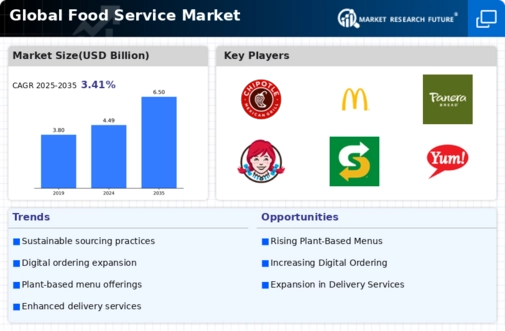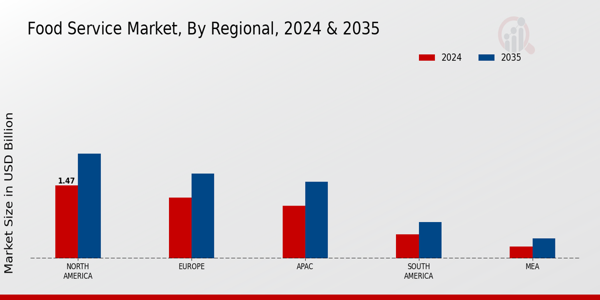Health and Wellness Trends
The Global Food Service Market Industry is increasingly influenced by health and wellness trends, as consumers become more health-conscious. There is a growing preference for nutritious and organic food options, prompting food service providers to adapt their menus accordingly. Restaurants are incorporating plant-based dishes and healthier alternatives to cater to this demand. This shift not only enhances customer satisfaction but also aligns with broader societal trends towards healthier living. As the market evolves, it is expected to reflect these changes, potentially leading to a compound annual growth rate of 3.42% from 2025 to 2035.
Globalization of Culinary Trends
The globalization of culinary trends profoundly influences the Global Food Service Market Industry. As cultures intermingle, consumers are exposed to diverse cuisines, leading to a demand for international flavors and dining experiences. This trend encourages food service providers to innovate and diversify their offerings, incorporating global dishes into their menus. The market's anticipated growth, reaching 4.49 USD Billion in 2024, reflects the increasing consumer interest in exploring new culinary experiences. This globalization not only enhances customer engagement but also fosters competition among food service providers to deliver unique and authentic dining experiences.
Rising Consumer Demand for Convenience
The Global Food Service Market Industry experiences a notable increase in consumer demand for convenience-driven dining options. This trend is largely fueled by busy lifestyles, as consumers seek quick and accessible meal solutions. Fast-casual dining establishments and food delivery services are gaining traction, reflecting a shift in consumer preferences. In 2024, the market is projected to reach 4.49 USD Billion, indicating a robust appetite for convenient food service options. This demand is expected to continue growing, as consumers increasingly prioritize speed and efficiency in their dining experiences.
Expansion of Delivery and Takeout Services
The expansion of delivery and takeout services significantly impacts the Global Food Service Market Industry. With the rise of third-party delivery platforms, restaurants are increasingly offering delivery options to reach a wider audience. This trend is particularly pronounced in urban areas, where convenience is paramount. The market's growth trajectory, with an expected value of 6.5 USD Billion by 2035, suggests that delivery and takeout services will continue to play a crucial role in shaping consumer dining habits. This shift not only meets consumer demands but also provides restaurants with new revenue streams.
Technological Advancements in Food Service
Technological innovations play a pivotal role in shaping the Global Food Service Market Industry. The integration of advanced technologies such as mobile ordering, contactless payments, and artificial intelligence enhances operational efficiency and customer experience. For instance, restaurants adopting AI-driven analytics can optimize menu offerings based on consumer preferences. As the industry embraces these technologies, it is likely to attract a broader customer base. The anticipated growth from 2024 to 2035, with a projected market value of 6.5 USD Billion, underscores the importance of technology in driving market expansion.



























Leave a Comment